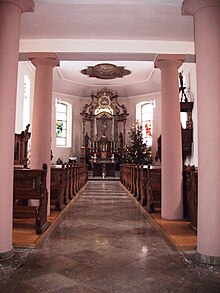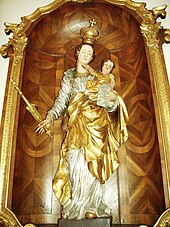St. Peter in Chains (Astheim)
The Roman Catholic parish church of St. Petrus in Ketten is a listed church building in Astheim , a district of the Trebur community in the Groß-Gerau district ( Hesse ).
The simple hall building with a three-sided choir closure was built in 1651. The church was consecrated on September 2, 1703 by the auxiliary bishop Johann Edmund Gedult von Jungsfeld . In 1774 the building was changed. The discontinued west tower with pointed helmet is from an older time from a previous church. The history of the patronage is shown on a ceiling painting .
The baroque gem testifies to the former Kurmainzer parish of Astheim. It was not until 1802/03 that Astheim was secularized and assigned to the province of Starkenburg (Hessen-Darmstadt).
Building history
Evidenced by the writing in the Astheim parish chronicle about the sending of a deacon (Johannes von Bensheim) to Astheim in 1302 suggests that a simple church, probably in the form of a barn and with a flat roof, must have existed since the 14th century. Others assume that a church has existed since the 12th century. This assumption is supported by archaeological finds such as a Gothic lintel and a Romanesque chapter in Astheim. Considerations of the special architecture of the church tower and its square base also point to previous buildings. The sculpture of Saint Margarte from the 16th century could have adorned the interior of a previous building. Assumptions suggest that there was a previous Romanesque building that could have been changed later, during the Gothic period. In any case, in the year of the Lord 1651, the parish chronicle reports that the entire church was destroyed due to a strong Rhine flood. Pastor Andreas Großer, through whom this tradition came to us, reports that the church tower on top of the choir and the church building had fallen over. In the same year, the lords of the Jakobskloster and the donors of Our Lady in Mainz, both of whom had had the right of patronage since 1493, decided to rebuild the parish church. But they did not want to take over the construction of a church tower. Therefore, the local court decided to build a tower at its own expense. The west tower was completed in 1657. On September 2, 1703, the Mainz Auxiliary Bishop Johann Edmund Gedult von Jungsfeld consecrated the church and three altars: one to Saint Peter, one to Saint Mary and one to Saint Sebastian. To this day, the parish fair is celebrated in Astheim on September 2nd of each year. St. Peter in chains was chosen as the patronage. As early as 1774, as Pastor Larger reports in the chronicle, the church was extended by “24 Schuh” to the east (probably around the choir). In the 19th century a gallery and two staircases on the west side next to the tower were built to the church. A sacristy was also added to the choir. The parish church has retained its essential shape from 1651/1774 to this day.
Furnishing
- The wooden baroque pulpit shows the four evangelists Matthew, Mark, Luke and John on its outside . On the pulpit is the figure of John the Baptist preaching Jesus.
- The Way of the Cross shows the suffering of Jesus in 14 stations. It is located on the sides of the nave. This Way of the Cross, inaugurated in 1944, replaced an older one from 1927, which was painted on the walls in the form of pictures.
- The font
- The two wooden statues in simple Baroque shapes from the 18th century were originally part of the side altars that were demolished in the 1960s. The right figure, whose year of origin is unknown, shows the patron saint of the parish church, Saint Peter. The apostle stands on a suggested rock, is girded with chains and carries two keys. He looks painfully at the crucified Christ at the high altar. On the left is the baroque figure of Mary with the child from 1770. Mary is depicted as the Queen of Heaven with a crown, scepter and noble robe. She carries the Infant Jesus in her arms and holds a cloth at the same time. The baby Jesus makes a gesture pointing towards his mother with his left arm. The loving and noble expression on the face of the Blessed Mother is particularly impressive.
- The baroque high altar from 1786/87 by Franz Hieronimus Hannisch (Mainz) shows the crucifixion scene. Jesus on the cross is flanked by the painful Mother of God and the favorite disciple John. Both figures belong to the older works of the Mainz sculptor Johann Georg Biterich. The high altar itself shows elements of the baroque, rococo and classicism in its simple shape. Its basic shape corresponds to the semicircular cibory altars in Mainz . It is crowned by a reredos, the eye of God in a triangle (symbol of the Trinity of God) in the cloud wreath and in turn surrounded by a halo.
- A Dreymann organ from the 19th century lines the gallery on the west side of the parish church. In 1833 the organ made by Bernhard Dreymann was installed in the church and checked by the grand ducal court organist Christian Heinrich Rinck . The original organ pipes on the organ's prospectus were given to the military during the First World War. In 1973/74 the organ was completely restored. However, their original shape and variety were also changed. During the most recent restoration in 2009, an attempt was therefore made to restore Dreymann's original shape and style.
- A monstrance from 1753 is also one of the art-historically valuable objects in the parish church. The radiation monstrance was made in 1751/1753 by the Augsburg silversmith Franz Mederle and donated in 1753 by Jacobus Möhlinger, a citizen of Astheim.
- The church had been equipped with bells since at least 1779. The three current bells were consecrated in 1953. Their bells have the Te Deum - or Salve Regina motif .
- In front of the parish church there is a baroque sandstone cross from 1710 in the former churchyard.
- The parish church in Astheim is decorated with three ceiling paintings. They were created by the Stuttgart church painter Julius Riester in the 1920s and show from the choir on the west side the scenes of the liberation of Peter from prison by an angel (salvation of St. Peter), the handover of the keys by Jesus to Peter and St. Cecilia of Rome , Patroness of church music.
- Also noteworthy is a late Gothic sculpture of the Mainz diocese patron, Saint Martin von Tours . The figure, created around 1500, hangs on the north side of the church. Martin is dressed in bishop's robes and carries a miter and crosier. On his left a beggar kneels pleadingly, made much smaller. Martin apparently hands him a piece of bread. The figure probably comes from the Gothic predecessor building of the baroque parish church.
- Another late Gothic figure from 1520, Saint Margaret of Antioch on a dragon, was brought from the parish church to the Middle Rhine State Museum in Mainz in 1899 .
Views
people
Prince Paul von Thurn und Taxis married his wife Elise Kreuzer in the parish church in 1868.
literature
- Georg Dehio: Handbook of the German art monuments, Hessen . Deutscher Kunstverlag, Munich 1966.
- Astheim. History and stories. Published by the Organizing Committee 1150 Years Astheim, Trebur 1999.
- Ludwig Baron Döry: Three Baroque Altars in Mainz. Höchst, Oberingelheim, Astheim. In: Mainz magazine. Middle Rhine Yearbook for Archeology, Art and History 73/74 (1979/1979), pp. 61–85.
- Ludwig Baron Döry: The Mainz sculptor Johann Georg Bitterich (1724–1789). In: Mainz magazine. Middle Rhine Yearbook for Archeology, Art and History 76 (1981), pp. 59–75.
- Werner Pelz: A contribution to the history of the former Kurmainzer parish of Astheim from 1770 to 1803. In: Archive for Middle Rhine Church History, 52 (2002), pp. 239-252.
- Churches, monasteries, pilgrimage routes in Rhineland-Palatinate, Saarland, Hesse and neighboring areas. Volume II. Mannheim 1997, pp. 171-173.
Web links
Individual evidence
- ^ Adam Gottron : Contributions to the history of the Mainz auxiliary bishop Johann Edmund Gedult von Jungsfeld (1652–1727) in: Archive for Middle Rhine Church History 9, 1957, pp. 95–117. The Astheimer Curb (church consecration) still takes place on the Sunday after September 2nd of each year.
- ↑ Georg Dehio ; Edited by Magnus Backes: Hessen . In: Handbook of German Art Monuments . First volume. Deutscher Kunstverlag, Munich, Berlin 1966, p. 31 .
- ^ Pelz, Kurmainzer parish Astheim
- ^ Pelz, Kurmainzer parish Astheim, here: p. 240.
- ↑ Astheim. History and Stories, p. 253; P. 269.
- ↑ Astheim. History and stories, pp. 253f.
- ^ Adam Gottron : Contributions to the history of the Auxiliary Bishop of Mainz Johann Edmund Gedult von Jungsfeld (1652–1727) in: Archive for Middle Rhine Church History 9, 1957, pp. 95–117, here: p. 100.
- ↑ Astheim. History and stories, pp. 254f.
- ↑ Astheim. History and Stories, p. 263.
- ↑ Astheim. History and Stories, p. 260.
- ↑ Astheim. History and Stories, pp. 256–260; on Biterich and his sculptures see Döry, Bitterich
- ↑ Astheim, History and Stories, p. 252; P. 260 f .; see also: Döry, baroque altars
- ↑ Astheim. History and Stories, p. 266
- ↑ Astheim. History and Stories, pp. 272f.
- ^ History
- ↑ Astheim. History and Stories, pp. 276–281.
- ↑ Astheim. History and stories, pp. 258f. The painter Julius N iester is probably incorrectly named there. After Gertrud Fels and Walter Appel, however, his name was Julius R iester (Fels, Gertrud P./Appel, Walter: Kirchl. Monument maintenance in the diocese of Mainz. Annual report 2001, in: AmrhKG 54 (2002), p. 505). See also the ceiling paintings, probably by the same painter, in the Church of St. Laurentius in Mainz-Ebersheim.
- ↑ Astheim. History and Stories, p. 270.
- ↑ Astheim. History and stories, pp. 270f.
- ^ Parish archives Astheim, Copulationsbuch, entry on June 7, 1868 by Pastor Ludwig Hermes.
Coordinates: 49 ° 56 '2.2 " N , 8 ° 23' 1.4" E









